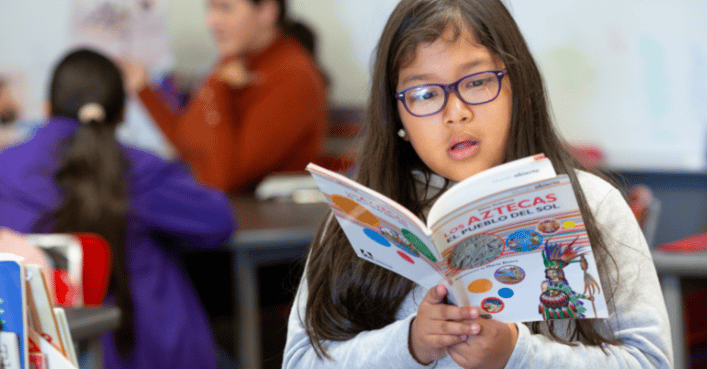
According to the OECD Programme for International Student Assessment (PISA), fifty percent of children and young people in the Spanish-speaking world do not understand what they are reading. In classrooms across the United States, educators are teaching the most linguistically diverse student population our country has ever seen and it is imperative that our instructional practices and educational resources reflect that. However, reading comprehension and explicit instruction is a challenge even for first language students and their teachers. Supporting the nearly 4 million native Spanish-speakers in their classrooms in developing reading proficiency and a love of reading can seem unattainable.
Read on for five strategies that are sure to build a lifelong love of reading in your Spanish-speaking students.
Instructional Strategies that Build a Love of Reading
- Get to know your students as readers. We all have unique preferences in food, activities, and entertainment – the same goes for books and reading habits! Start things off with a reading interest survey that gathers information about each student’s preferences regarding book genre, favorite places to read, authors, and general attitudes toward reading. BeeReaders includes an initial student survey to assist in understanding how they feel about reading and their reading habits. In addition, students are able to select topics of interest so that their short text challenges, called desafíos, are provided to them based upon their reading level and areas of interest. If a child doesn’t like reading, that is your starting point – help them fall in love with reading by exposing them to relatable characters and books on a variety of reading levels.
- Gamify and reward reading practice and progress. Who doesn’t love to win? Small wins are some of the most powerful. Celebrate small and big milestones – from improving reading rate by 10 words per minute to moving up a reading level. It all matters and deserves celebration. Even just “rebranding” literacy quizzes or tests as challenges and quests can build more student interest in reading! When gamifying reading tasks, ensure you clearly define a set of rules and goals, implement a (hopefully rapid) feedback system, and communicate freedom to fail and try again (just like in a video game). BeeReaders is a strong example of gamified reading instruction and was created specifically for Spanish-speaking students. BeeReaders uses a badges, medals, and trophies reward system to incentivize students to build great reading habits and achieve their reading goals. In addition, students can earn Beecoins through short-text challenges which they can use to purchase a special selection of books, as well as select new skins and avatars. Check out their state-of-the-art student and teacher platform in this video and their rewards system here.
- Leverage sheltered instructional strategies. Sheltered English instruction is an instructional approach that makes classroom instruction in English more understandable for English Language Learners. This is accomplished by regularly integrating physical activity into learning, providing clear visual aids, establishing a text-rich environment, and more. By providing these scaffolds, you begin to remove fear or anxiety students may have about reading, or other academic endeavors, and help them see themselves as the capable learners they are. On the BeeReaders’ digital reading experience, there are built-in support tools like an integrated dictionary, narrator feature, font type and size adjustments, notes and highlighting capabilities, linguistic variations, and built-in comprehension questions embedded throughout, targeted to students’ reading levels.
- Diversify your library and your literacy approach. Developing a love of reading starts with finding books you love. Just as every child is different, every reader is different, and every classroom or school library needs to reflect that. Some books are “mirrors” (books that contain characters and experiences that your students can relate to) and others are “windows” (books that offer perspectives different from your students’). Round out your collection with all genres (including comics and graphic novels) across all reading levels. While finding high-interest books for your Spanish-speaking students can be difficult, BeeReaders offers an extensive reading learning experience with over 500 authentic Spanish books and 10,000 short texts in Spanish and counting, accessible on computer, tablet, or mobile device both at school and at home! Students are able to see themselves in the wide variety of texts from around the Spanish-speaking world. Just as you diversify book selections for students, switch up the way you present texts. Rotate between independent reading, buddy reading, and read aloud so students can experience and engage with books in a variety of formats.
- Involve families in their child’s reading experience. Parents play a critical role in their students’ success and in developing a love of reading. Encourage parents to share with their child their own positive reading experiences. Let them see their own parents reading at home to see both the pleasure they gain and the importance of reading. Have parents help their children select texts that match their areas of interest as well as some topics that they may be interested in knowing more about. BeeReaders goes a step further and includes a Family app where families are actively involved in their student’s reading journey and are able to see their progress, badges earned, reading time, and so much more. Check out the reading tips that BeeReaders shares with their parents.
Help ELL and Dual Language Students Be Stronger Readers with BeeReaders
BeeReaders is the result of experienced reading comprehension specialists and top digital learning experts in the Spanish-speaking world coming together to redefine possibilities for Spanish-speaking students. If you want to better meet the needs of your K-12 Spanish-speaking students and help accelerate their reading growth, request a BeeReaders demo today and watch your students fall in love with reading!

